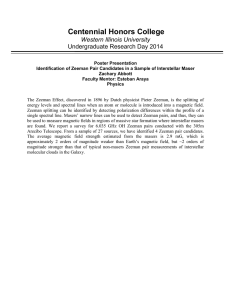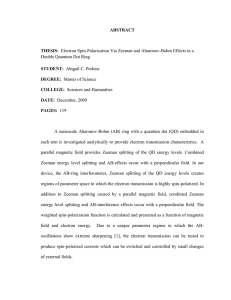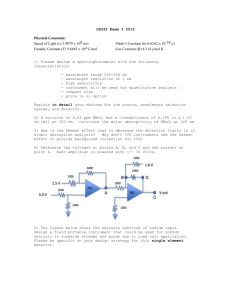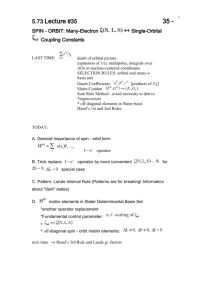36 - 1 Lecture ∑ (
advertisement
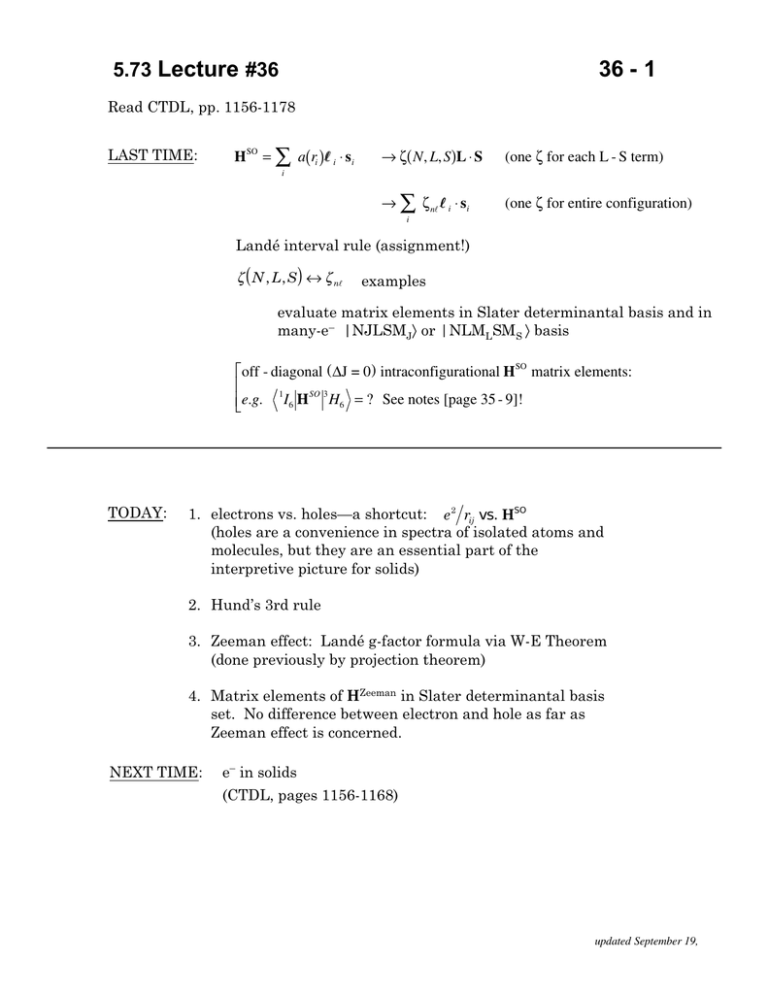
5.73 Lecture #36
36 - 1
Read CTDL, pp. 1156-1178
LAST TIME:
HSO = ∑ a(ri )l i ⋅ si
→ ζ( N , L, S )L ⋅ S
(one ζ for each L - S term)
→ ∑ ζ n l i ⋅ si
(one ζ for entire configuration)
i
l
i
Landé interval rule (assignment!)
ζ (N , L, S ) ↔ ζ n
l
examples
evaluate matrix elements in Slater determinantal basis and in
many-e– |NJLSMJ⟩ or |NLMLSMS ⟩ basis
off - diagonal ( ∆J = 0) intraconfigurational HSO matrix elements:
1
SO 3
e.g. I6 H H6 = ? See notes [page 35 - 9]!
TODAY:
1. electrons vs. holes—a shortcut: e 2 rij vs. HSO
(holes are a convenience in spectra of isolated atoms and
molecules, but they are an essential part of the
interpretive picture for solids)
2. Hund’s 3rd rule
3. Zeeman effect: Landé g-factor formula via W-E Theorem
(done previously by projection theorem)
4. Matrix elements of HZeeman in Slater determinantal basis
set. No difference between electron and hole as far as
Zeeman effect is concerned.
NEXT TIME:
e– in solids
(CTDL, pages 1156-1168)
updated September 19,
5.73 Lecture #36
36 - 2
1. relationship between configurations with N e– vs. N “holes”
subshell
(nl)N
1 / 2 full subshell
# e−
s
1
p d f
3 5 7
for p5 is it necessary to consider all 5 e–?
e.g.
1α 1β0α 0β − 1α = np5 2 P ML = 1, MS = 1 / 2
(±1β is the unoccupied spin - orbital. It is the "hole")
HSO np5 2 P ML = 1, MS = 1 / 2 = ζ np ∑
l iz s iz
1α 1β0α 0β − 1α
i
1 1
= h2ζ np − + (0 − 0) −
2 2
so expectation value of HSO :
but for single e– (with
the same ML, MS as
the five e–)
5e −
1 −
5e
2
1
= − ζ np h2
2
HSO np1 2 P ML = 1, MS = 1 / 2 = ζ npl z s z 1α
1e −
1
= + ζ np h2
2
is the sign flip just a coincidence? NO!
TRICK: Hole is exactly equivalent to e– (for identical LMLSMS or JLSMJ)
except that the sign of its charge is reversed.
*
no effect on e2/rij because 2 interacting particles have charge of the
same sign (either both e– or both hole), so e2/rij is always a
repulsive interaction. [What happens for f13p? Certainly different
from fp!]
*
reverse sign for HSO because HSO is a relativistic electrostatic
interaction between e– and nucleus (+ charge). Replacing e– by h+
and leaving the sign on the nucleus the same reverses the sign of
HSO!
updated September 19,
5.73 Lecture #36
p1 ↔ p5
p2 ↔ p4
d1
d2
d3
d4
36 - 3
↔ d 9 etc.
↔ d8
↔ d7
↔ d6
pretend that holes are e–, Slater determinants describe spin-orbitals occupied by holes.
*
all Fk, Gk, ζnl remain positive (repulsions)
* all e2/rij energy level patterns are unaffected
*
all ζ(N,L,S) reverse sign
Look at Tinkham 6-2, page 187 figure.
ζnd vs. ζ(N,L,S) for lowest L-S term of (3d)N configuration
sign change, too rapid evolution with Z
3
∝ Z eff
– periodicity, isoelectronic series, aufbau too
INSIGHT — regularization of trends
EXTRAPOLATION
ASSIGNMENT
LABOR SAVING!
Shielding systematics:
Z ∅Z+1
Zeff ∅ Zeff + 1 – 0.5
:
shielding
Burns’ Rules. G. Burns, J. C. P. 41, 1561 (1964).
updated September 19,
5.73 Lecture #36
36 - 4
updated September 19,
5.73 Lecture #36
36 - 5
2. Hund’s Third Rule
Consider only MAX-S, MAX-L L-S term, which Hund’s 1st and 2nd rules identify as
the lowest lying within the (nl)N configuration
This L-S term will always be a single Slater determinant for the ML = LMAX, MS = SMAX
component
L MAX , M L = L MAX , SMAX , MS = SMAX =
α (l - 1)α …
l
(as many α spins as possible)
diagonal element of HSO
(
ζ (( n )
ML
)
)=ζ
MS
ζ ( nl) , L MAX , S MAX L MAX S MAX = ζ nl ∑ ml i msi
l
N
N
, L MAX , S MAX
i
Σml i msi
nl
L MAX S MAX
shell less than 1 / 2 full, N < 2l + 1, all spins are α
S MAX ?
∴S = N / 2
if all spins are α, maximize ML by putting 1e– into each
ml starting at ml= l and working downward.
LMAX?
(l − 1)4
(l − N +3
M L MAX = l1+444
+2
…4444
1) = N[l − (N − 1) 2]
N terms in sum
get l from each term in sum
all spins α
(
)
ζ nl N L MAX , S MAX = ζ nl
LMAX
1
1
Σml i
ML
2
2
= ζ nl
L MAX ( N / 2)
L MAX N 2
(
)
SMAX
= ζ nl / N
WHICH OR
IMPLIES
ζ nl 2S MAX
!
updated September 19,
5.73 Lecture #36
Shell 1/2 full
36 - 6
N = 2l + 1, all spins α ,
∑
mi =0
l
i
S = N 2, L = 0
lowest L - S term is
LJ = N + 1SN
2S+1
2
(single J for all L = 0 terms) - no fine structure
Shell more than 1/2 full
SMAX?
2l + 1 α spins
N − (2l + 1) β spins
[
SMAX
LMAX?
]]
[
1 (
2l + 1) − N − (2l + 1) = 2l + 1 − N 2
2
= 2l + 1 − N 2
MS =
for the 2l + 1 α spins
∑
mi =0
l
for the N − (2l + 1) β spins,
∑m
= l + (l − 1) + … = M L = L MAX
li
α spins
β spins
0
(
ζ nl N L MAX , S MAX
)
LMAX
1
1
ζ nl ∑ ml i − ∑ ml i
2
2 (α )
(β )
=
L MAX S MAX
=
ζ nl ( −1 2)L MAX
[
]
L MAX (2l + 1) − N 2
=−
ζ nl
2 S MAX
=
−ζ nl
2(2l + 1) − N
# of holes
!
Summary for lowest energy L - S term:
**
ζ(nl N , L MAX ,SMAX ) > 0 for less than 1 / 2 full, = 0 for 1 / 2 full, < 0 for more than 1 / 2 full
**
ζ(nl N , L MAX ,SMAX ) = ±
ζn
of e −
of h +
l
#
#
updated September 19,
5.73 Lecture #36
36 - 7
Hund’s third rule: ONLY FOR LOWEST ENERGY L-S term, lowest J component is
J = L−S
for N < 2l + 1 “regular”
J=S
J = L+S
N = 2l + 1 no fine structure
N > 2l + 1 “inverted”
sign of ζ(NLS)
# of J components
extreme J values (recognize via interval rule)
magnitude of ζnl
# of MJ components
Zeeman tuning rates
Assignments:
3. Zeeman effect in many-e– atoms
(
HZeeman = − µ 0
h
)(L
z
)
+ 2S z Bz
1.399613 MHz/Gauss
Bohr magneton
(Used γ previously)
remember that HZeeman is awkward in JMJLS⟩ basis set
W–E Theorem trick to simplify HZeeman:
consider only matrix elements diagonal in J [There are also
nonzero matrix elements of HZeeman off-diagonal in J.]
HSO and e2 r are strictly diagonal in J . Since HZeeman has sum of 2 vectors with respect to
ij
J, W - E Theorem says it can have ∆J = 0, ±1 matrix elements. When we evaluated
matrix elements of Lz and S z in JM J LS the hard way, we saw that there were nonzero
∆J = ±1 matrix elements.
Our special case ∆J = 0 is useful as long as
( )
( )
J ′ HZeeman J << EJ0′ − EJ0
∝ Bz
(This fails at high Bz when ζ(nLS) is small.)
updated September 19,
5.73 Lecture #36
36 - 8
for ∆J = 0 matrix elements, replace both L z and Sz by J z
JM ′LS L JMLS = JLS L JLS JM ′LS J JMLS
JM ′LS S JMLS = JLS S JLS JM ′LS J JMLS
but J = L + S. Add the 2 equations
=( L + S ) J
1442443
J
(1 – α)
H Zeeman =
−µ 0
h
=1
(α)
[This trick is equivalent to, but
not as elegant as, the projection
Theorem.]
1 − α )J z + 2{
αJ z Bz =
(1
4
2
4
3
Lz
2 Sz
part
part
−µ 0
h
Bz (1 + α )J z !
Trick to evaluate α :
L2 = (J − S) = J2 + S2 − 2J ⋅ S
2
diagonal JM J LS matrix element of both sides
h
2
L (L + 1) = h 2 J( J + 1) + h 2S(S + 1) − 2 JMLS J ⋅ S JMLS **
⇓
completeness: J has ∆J = 0
selection rule, L has ∆L = 0,
S has ∆S = 0, J ⋅ S is scalar with
respect to J, ∆M = 0
JMLS J ⋅ S JMLS =
∑
JMLS J J ′M ′L ′S ′ J ′M ′L ′S ′ S JMLS
J ′M ′L ′S ′
= JMLS J JMLS JMLS S JMLS
αJ
(
)
= α JMLS J JMLS = αJ J + 1 h2
2
Plug this into the ** equation above and rearrange:
α=
J( J + 1) + S(S + 1) − L (L + 1)
2 J( J + 1)
updated September 19,
5.73 Lecture #36
36 - 9
from
H Zeeman
from
Lz
2S z
8 }
67
= −µ 0 Bz M J (1 − α ) + 2α
= −µ 0 Bz M J [1
+3
12
α]
gJ
Landé g-value
gJ ≡ 1 + α = 1 +
S
J ( J + 1) + S( S + 1) − L( L + 1)
2 J ( J + 1)
1 dE 1
= gJ
* gJ is Zeeman tuning coefficient = −
µ 0 dB z M J
* equally spaced MJ components
* excellent diagnostic for different L,S of same J
r
r
gJ is large when L and S are parallel (i.e. since J = L + S ,
r r
parallel L,S at constant J means smallest possible L in order to
have largest possible S)
L
r r
gJ small when L,S are antiparallel
e.g.
J =3 :
L = 0, S = 3
gJ
L = 3, S = 1 :
2.000
J =4
(parallel)
L = 1, S = 2
1.667
J=3
1.250
1.1667
L = 2, S = 1 L = 3, S = 0
1.333
1.000
J=2
(antiparallel)
0.667
* gJ decreases at constant J when S is replaced by L.
* gJ decreases at constant L and S as J decreases from L+S to |L–S|.
How to determine J:
*
apply B-field and count MJ components
(constant splittings in upper and in lower L-S term)
*
measure gJ (Quantum Beats)
*
polarization dependent Zeeman splitting pattern: ∆MJ = 0 for z
polarized, ∆MJ = ±1 for x or y polarized, ∆MJ = +1 or –1 for circularly
polarized
updated September 19,
5.73 Lecture #36
36 - 10
Compare direct evaluation of Zeeman matrix element to gJ determined
independently.
Matrix Elements of HZeeman in Slater determinantal basis set?
e.g.
f 2 3H 6 M J = 6 = 3α 2α
(
HZeeman = − µ 0
h
)B ∑ (
z
+ 2s iz
l iz
i
)
3α 2α H Zeeman 3α 2α = −(µ 0 B z )[( 3 + 1) + ( 2 + 1)]
= −7 µ 0 B z
Now compare with gJ equation:
3
H6 6 H Zeeman 3 H6 6 = −(µ 0 B z ) gJM J
gJ = 1 +
(
= − µ 0 Bz
6 ⋅7 + 1⋅ 2 − 5 ⋅ 6
1 7
= 1+ =
2 ⋅ 6 ⋅7
6 6
) 7 6 = −7µ B
6
0
0
agrees!
updated September 19,
5.73 Lecture #36
36 - 11
Hole vs. e– for Zeeman effect.
What about a single hole state? Does Zeeman effect reverse sign?
(
f 13 2 F7/2 7 / 2 = 3α …− 3α 3β…− 2β
same ML , MS
1 2
f F7/2 7 / 2 = 3α
)
E Zeeman f 13 2 F7/2 7 / 2 = −(µ 0 B z )[(0 + 7 ) + ( 3 − 6)]
= −4µ 0 B z
(
α-spins
7e–
β-spins
6e–
)
E Zeeman f 1 2 F7/2 7 / 2 = −(µ 0 B z )[ 3 + 1] = −4µ 0 B z
same as f 13
no sign change for Zeeman for e– vs. h+. WHY?
updated September 19,

